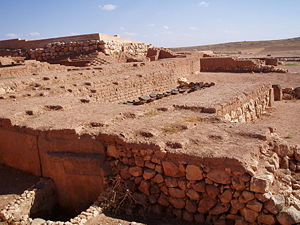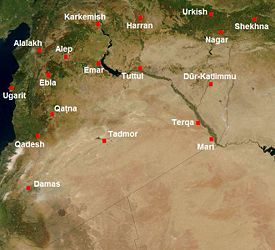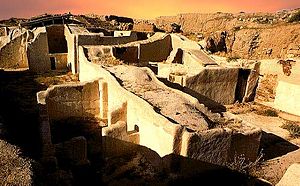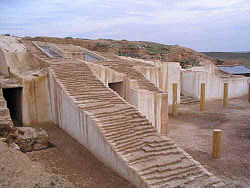Ebla
Ebla (Arabic: عبيل، إيبلا, modern Tell Mardikh, Syria) was an ancient city about 55 km southwest of Aleppo. It was an important city-state in two periods, first in the late third millennium B.C.E., then again between 1800 and 1650 B.C.E. The site is famous today mainly for archives of about 17,000 cuneiform tablets, dated from around 2250 B.C.E., in Sumerian and in Eblaite —a previously unknown Semitic language.
Around the time the Ebla tablets were created, the city was a major economic center with a series of kings who were elected rather than ruling through dynastic succession, until the coming of King Ibrium and his son Ibbi-Sipish. Its religion appears to have included both Semitic and Sumerian influences, and many ancient biblical personal names and place names have been found among the tablets. Ebla was destroyed c. 2200 B.C.E. by the emerging Akkadian empire, being rebuilt about four centuries later by the Amorites. After a second destruction by the Hittites, it existed only as a village and disappeared from around 700 C.E. until its rediscovery in 1964.
The Ebla tablets represent one of the richest archaeological finds of recent times in terms of the information they yield about the economy, culture, religion, and daily life of the Middle East and Mesopotamia, not to mention Ebla itself.
Discovery and excavation
Ebla was well known in concept long before its modern rediscovery, being mentioned in the Mari archives and several other ancient Mesopotamian texts. Akkadian texts from c. 2300 B.C.E. testify to its wide influence and later inscriptions in the annals of Thutmose III and Hittite texts from Anatolia also speak of the city.
In 1964, Italian archaeologists from the University of Rome La Sapienza directed by Paolo Matthiae began excavating at Tell Mardikh in northern Syria. In 1968 they recovered a statue dedicated to the goddess Ishtar bearing the name of Ibbit-Lim, a previously known king of Ebla. This inscription identified the city, long known from Egyptian and Akkadian inscriptions.
In the next decade the team discovered a palace or archive dating approximately from 2500–2000 B.C.E. A cache of about 17,000 well-preserved cuneiform tablets were discovered in the ruins.[1] About eighty percent of the tablets are written in Sumerian. The others are in a previously unknown Semitic language now known as 'Eblaite. Sumerian-Eblaite vocabulary lists were found with the tablets, allowing them to be translated. Archaeologists are divided as to whether the language should be classified as West Semitic or East Semitic.
The larger tablets were discovered where they had fallen from archival shelves, allowed the excavators to reconstruct their original position on the shelves, leading to the discovery that they were apparently shelved according to subject. The archive includes records relating to provisions and tribute, law cases, diplomatic and trade contacts, and a scriptorium where apprentice scribes copied texts.
Ebla in the third millennium B.C.E.
The name "Ebla" means "White Rock," and refers to the limestone outcrop on which the city was built. Although the site shows signs of continuous occupation since before 3000 B.C.E., its power grew and reached its apogee in the second half of the following millennium. Ebla's first apogee was between 2400 and 2240 B.C.E. Its name is mentioned in texts from Akkad around 2300 B.C.E. Excavations have unearthed palaces, a library, temples, a fortified city-wall, and subterranean tombs indicating that the Ebla had been an important urban center.
Most of the Ebla tablets, which date from the above-mentioned period, are about economic matters. They provide important insights into the everyday life of the inhabitants, as well as the cultural, economic, and political life of ancient northern Syria and Near East. Besides accounts of state revenues, the texts also include royal letters, Sumerian-Eblaite dictionaries, school texts, and diplomatic documents, such treaties between Ebla and other towns of the region.
The tablets list Ebla's most powerful king as Ebrium, or Ibrium, who concluded the so-called "Treaty with Ashur," which offered the Assyrian king Tudia the use of a trading post officially controlled by Ebla. The fifth and last king of Ebla during this period was Ibrium's son, Ibbi-Sipish. He was first Eblaite king to succeed his father in a dynastic line, thus breaking with the established custom of electing its ruler for a fixed term of office, lasting seven years.
Some analysts believe this new dynastic tradition may have contributed to the unrest that was ultimately instrumental in the city's decline. In the meantime, however, the reign of Ibbi-Sipish seems to have been a time of relative prosperity, in part because the king was given to frequent travel abroad, leading to greater trade and other diplomatic successes. For example, it was recorded both in Ebla and Aleppo that he concluded specific treaties between the two cities.
Economy
Ebla in the third millennium was a major commercial center with influence over a number of nearby smaller city-states. Its most important commercial rival was Mari. The Ebla tablets reveal that its inhabitants owned about 200,000 head of mixed cattle (sheep, goats, and cows). Linen and wool, seem to have been its main products. The city's also traded in timber from the nearby mountains and perhaps from Lebanon. Woodworking and metalworking other important activities, including the smelting of gold, silver, copper, tin, and lead. Other products included olive oil, wine, and beer.
Most of Ebla's trade seems to have been directed toward Mesopotamia, chiefly Kish, but contacts with Egypt are also attested by gifts from pharaohs Khafra and Pepi I. Handicrafts may also have been a major export. Exquisite artifacts have been recovered from the ruins, including wood furniture inlaid with mother-of-pearl and composite statues created from various colored stones. The artistic style at Ebla may have influenced the quality work of the Akkadian empire (ca. 2350–2150 B.C.E.).
Government
Ebla's form of government is not completely clear, but the city appears to have been ruled by a merchant aristocracy that elected a king and entrusted the city's defense to paid soldiers. Among the kings mentioned in the tablets are Igrish-Halam, Irkab-Damu, Ar-Ennum, Ibrium, and Ibbi-Sipish. It was Ibrium who broke with tradition and introduced an dynastic monarchy. He was followed by his son Ibbi-Sipish.
Religion
An Eblaite creation hymn was discovered among the tablets, existing in three distinct version, all of which contain the following verse:
- Lord of heaven and earth:
- The earth was not, you created it
- The light of day was not, you created it
- The morning light you had not [yet] made exist.
Its location apparently gave Ebla exposure to several religious cultures. Thus, some well-known Semitic deities appear at Ebla, including Dagan, Ishtar, and Hadad, plus several Sumerian gods such as (Enki and Ninki, and the Hurrian deities (Ashtapi, Hebat, and Ishara). Some otherwise unknown goes are also mentioned, namely (Kura and Nidakul.
Archaeologist Giovanni Pettinato has noted a change in the theophoric names in many of the tablets found in the archive from "-el" to "-yah." For example "Mika’el" transforms into "Mikaya." This is considered by some to constitute an early use of the divine name Yah, a god who believed to have later emerged as the Hebrew God Yahweh. Bottero has suggested that this shift indicates the popular acceptance of the Akkadian God Ea (Sumerian: Enki) introduced from the Sargonid Empire, which may have been transliterated into Eblaite as YH. This theory has not gained universal acceptance, however, and other scholars have insisted the sign in question is correctly transliterated IA.[2]
Many Old Testament personal names that have not been found in other Near Eastern languages do have similar forms in Eblaite, including a-da-mu/Adam, h’à-wa /Eve, Abarama/Abraham, Bilhah, Ishmael, Isûra-el, Esau, Mika-el, Mikaya/Michaiah, Saul, David). Also mention in the Ebla tablets are many biblical locations: for example Ashtaroth, Sinai, Jerusalem (Ye-ru-sa-lu-um), Hazor, Lachish, Gezer, Dor, Megiddo, Joppa, etc. [3]
Destruction
Sargon of Akkad and his grandson Naram-sin, the conquerors of much of Mesopotamia, each claim to have destroyed Ebla. The exact date of destruction is the subject of continuing debate, but 2240 B.C.E. is a probable candidate.
During the next three centuries, Ebla was able to regain some economic importance in the region, but never reached its former glory. It is possible the city had economic ties with the nearby city of Urshu, as is documented by economic texts from Drehem, a suburb of Nippur, and from findings in Kultepe/Kanesh.
Ebla in the second millennium B.C.E.
Several centuries after its destruction by the Akkadians, Ebla managed to recover some of its importance. Its second apogee lasted from about 1850 to 1600 B.C.E. During this period the people of Ebla were Amorites. Ibbit-Lim was the first known king of Ebla during this time.
Ebla is mentioned in texts from Alalakh around 1750 B.C.E. The city was destroyed again in the turbulent period of 1650–1600 B.C.E., by a Hittite king (Mursili I or Hattusili I).
Ebla never recovered from its second destruction. It continued only as a small village until the seventh century CE, then was deserted and forgotten until its archaeological rediscovery.
Notes
- ↑ An up-to-date account for the layman, written by the head of the archaeological team that uncovered Ebla is Paolo Matthiae, The Royal Archives of Ebla (Skira) 2007.
- ↑ Gordon, Cyrus H. ed. Eblaitica : essays on the Ebla archives and Eblaite language (Eisenbrauns, 1987)
- ↑ An early assessment was Clifford A Wilson , The impact of Ebla on Bible records: The sensational Tell Mardikh (1977).
ReferencesISBN links support NWE through referral fees
- Cornelius, Izak, and Louis C. Jonker. From Ebla to Stellenbosch: Syro-Palestinian Religions and the Hebrew Bible. Abhandlungen des Deutschen Palästina-Vereins, Bd. 37. Wiesbaden: Harrassowitz in Kommission, 2008. ISBN 9783447057769
- Gordon, Cyrus Herzl, and Gary Rendsburg. Eblaitica: Essays on the Ebla Archives and Eblaite Language. 4. Winona Lake, Ind: Eisenbrauns, 2002. ISBN 9781575060606
- Matthiae, Paolo. Ebla: An Empire Rediscovered. Garden City, N.Y.: Doubleday, 1981. ISBN 9780385129046
- Pettinato, Giovanni. The Archives of Ebla: An Empire Inscribed in Clay. Garden City, N.Y.: Doubleday, 1981. ISBN 9780385131520 ISBN 9780385131520
External links
- Capsule history of Ebla.. www.syriagate.com. Retrieved August 16, 2008.
Credits
New World Encyclopedia writers and editors rewrote and completed the Wikipedia article in accordance with New World Encyclopedia standards. This article abides by terms of the Creative Commons CC-by-sa 3.0 License (CC-by-sa), which may be used and disseminated with proper attribution. Credit is due under the terms of this license that can reference both the New World Encyclopedia contributors and the selfless volunteer contributors of the Wikimedia Foundation. To cite this article click here for a list of acceptable citing formats.The history of earlier contributions by wikipedians is accessible to researchers here:
The history of this article since it was imported to New World Encyclopedia:
Note: Some restrictions may apply to use of individual images which are separately licensed.



